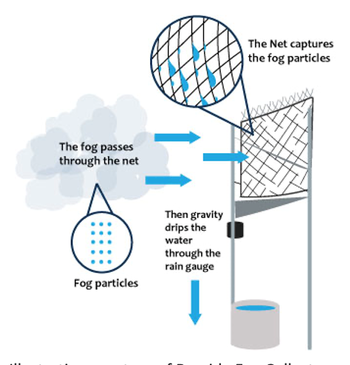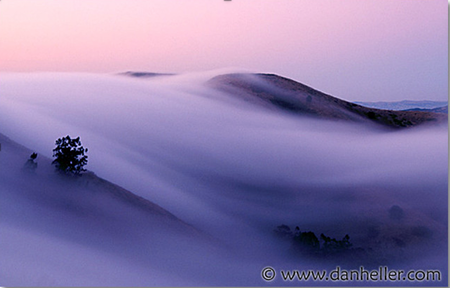The Latest Dirt - Sept 2023
Water, Water: Everywhere and Nowhere, All At Once
Reporting from Oslo, Norway
By Liv Imset
Lately, it seems like water, in one way or another, makes headlines every day. There are reports of either not enough or too much at once. Some recent examples:

Illustration courtesy of Bayside Fog Collectors.
Then came the first winter storms. We rejoiced as the ground was soaked, and there was promise of full reservoirs. The rainy season ended, the Sierras were covered in record snow, and the urgent need to conserve water faded quickly from the forefront. All was ‘quiet on the western front’ for a bit, then we seemed to whiplash in the last month or so. Descriptions of record-breaking storms soon followed reports on warming ocean temperatures.
“In a news conference, Deanne Criswell, administrator of the Federal Emergency Management Agency, said Idalia made landfall with winds of up to 120mph and as much as 10 inches of rain.”
I was shocked to turn on the news the day I arrived in Norway in early August to see a reporter standing in knee-high water in my mother’s tiny hometown reporting on the destruction from storm ‘Hans.’ A day later, the news of the local destruction made it to the US, check out the video. [2]
While some of this water is absorbed in the ground, our current infrastructure generally can’t capture the water from these big storms. Earlier this year, the New York Times reported[4] on all the water we lost out to sea, tens of billions of gallons of rainwater. It was mid-January, and the storms continued late into the spring.
And then, finally, did you see the recently published article in the New York Times on groundwater? The status of groundwater often gets overlooked or underreported. The report gave a comprehensive view of the related problem of its decline. Please check it out.
https://www.nytimes.com/interactive/2023/08/28/climate/groundwater-drying-climate-change.html
It would be great if we could harvest and capture all of that fresh rainwater as it falls from the sky before it gets added to the salty oceans and begins the water cycle again, but the changes are happening too fast, and we are too slow to adapt. Demand is outstripping supply as we continue using water, primarily traditionally for agricultural and domestic use. According to a report[5] published by the United States Geological Survey (USGS), as of 2015, the United States uses 322 billion gallons of water per day (Bgal/day). The three largest water-use categories were irrigation (118 Bgal/day), thermoelectric power (133 Bgal/day), and public supply[6] (39 Bgal/day), cumulatively accounting for 90 percent of the national total. Irrigation and groundwater use was increasing while water for thermoelectric power was decreasing.
So, in the face of droughts and deluges, how can we use water wisely?
As Master Gardeners, we are well versed in plants’ water needs. There is no life without water; too much water can also put plants in danger. We were taught to identify the watering needs of different plant types and calculate water delivery through the various irrigation systems set up in our home landscapes. We know we can optimize our watering schedules if we’ve done our homework. We will use the least amount of water possible to provide for the needs of our plants. This practice conserves water while providing for optimal growing conditions, at least regarding water.

Photo by Dan Heller.
Last year, we installed two sub-irrigation systems[7] in the raised beds. We saw that these systems used about 1/3 of the water of a conventional raised bed to grow tomatoes, squash, cucumbers, beans and more edible plants. This past winter, the storms filled the raised beds’ sub-irrigation systems, creating a water reservoir that the plants have continued to utilize. The plants in the raised beds with the larger sub-irrigation systems have not required additional watering all summer (except for water at the initial planting). We also devised a water collection system using the existing drainage ditch and filled a 1,500–gallon storage tank with rainwater from the first couple of winter storms. If we had more tanks, we would have captured much more.
This year, we have finished the installation of two standard fog collectors. Fog collection is harvesting water from fog using large pieces of vertical mesh netting to trap the droplets and direct the water into an underlying trough connected to a storage container. See the illustration below. A standard fog collector is a piece of research instrumentation made to specific standards to test this site’s ability to harvest water from the fog. A typical fog collector can collect up to 9 gallons of water daily when the conditions are right.
While you may have yet to hear of a fog collector, they have been used successfully in certain regions worldwide, such as Morocco, Bolivia, and the California Bay Area, where wind-driven fog is a recurring phenomenon. The first fog collector in California was deployed by Hangar 1 Vodka at Sutro Towers, followed by an installation at Half Moon Bay. They used the water collected to distill “Fog Point” vodka! [8] Most other installations around the globe have been used for the more basic need of supplying drinking water in otherwise arid regions.
We are piloting the systems at the Water Conservation Garden to determine if the site is suitable for a larger installation. If so, it may be possible to collect water on site in the summer months for the purposes of the garden.
Our goal for the garden is to gather enough water from onsite resources so that no external water delivery is required to sustain our operations. The fog collectors may become a part of that equation. It is too early to tell if the site is suitable for fog harvesting but in the meantime, they are a novelty that has generated much discussion and inspired one Master Gardener to install a system at her home (also in the works).
I’ve always loved watching the fog roll in. Now, I will wonder if the fog is hitting the mesh just right, and we will see drops of water collecting in the troughs. Stay tuned for our ongoing reports on the pilot projects out at the Water Conservation Garden! I hope to see you there in the near future.
[1] https://www.drought.gov/drought-status-updates/california-nevada-drought-status-update-10-18-22#:~:text=Water%20Year%202022%20started%20wet,moderate%2Dto%2Dexceptional%20drought.
[2] https://www.foxweather.com/extreme-weather/norway-flooding-homes-crushed-video-storm-hans
This news was followed shortly after that with reports of Hilary[3] from near home, 2 inches of rain fell in Death Valley (a year’s worth), and 8.5 inches at Mt Wilson.
[3] https://www.latimes.com/california/story/2023-08-21/hurricane-hilary-obliterated-daily-rainfall-records-across-souther-california
[4] https://www.nytimes.com/2023/01/13/us/california-drought-storms-water-storage.html
[5] https://www.usgs.gov/faqs/how-much-water-used-people-united-states#:~:text=As%20of%202015%2C%20the%20United,percent%20of%20the%20national%20total
[6] Public-supply systems deliver water to domestic, industrial, commercial, and other users.
[7] See Sustainable Gardening Pilot Project Report #1 by Liv Imset, The Latest Dirt May 2022 May 2022 https://conta.cc/3L5B2tH
[8] https://hangarone.com/fogpoint-vodka/
